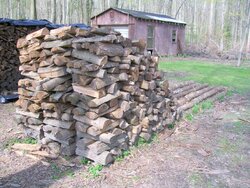We are into our 4th year of burning. At this point, we have 1 more year's worth of wood, so we need more, right away. Honestly, I've found the management of the wood to be the hardest part. When to buy/collect, how and where to stack, which wood is the driest, etc.
Specifically, my problems are; not a super good space. We have 3 acres, but when burning 4 cord a year, that's a lot of wood hanging around, about 12-16 cord. It's under a bunch of polar trees, lots of leaves and branches. Uneven ground.
I have read that the best way to stack it is single row, with space in between, which I do. But now, that spreads it out, and it's hard to top cover. This year, the top 3 or so layers of wood are getting a little skanky due to the leave that fall in the stacks. As it is, getting enough concrete blocks and skids to stack on, then some conveyor belt and rubber roofing to cover it is getting to be a huge pain, mess, and expense. Ideally, I'd like to build a drying shed/s, so the wood is always top covered. Unfortunately, I'd have to do some grading first, as the spot is somewhat uneven.
As the saying goes, "There is no problem that cannot be overcome by the liberal application of MONEY."
Also unfortunately, we're trying to save money on heating, not spend more. How do you guys manage your wood? Any suggestions?
Specifically, my problems are; not a super good space. We have 3 acres, but when burning 4 cord a year, that's a lot of wood hanging around, about 12-16 cord. It's under a bunch of polar trees, lots of leaves and branches. Uneven ground.
I have read that the best way to stack it is single row, with space in between, which I do. But now, that spreads it out, and it's hard to top cover. This year, the top 3 or so layers of wood are getting a little skanky due to the leave that fall in the stacks. As it is, getting enough concrete blocks and skids to stack on, then some conveyor belt and rubber roofing to cover it is getting to be a huge pain, mess, and expense. Ideally, I'd like to build a drying shed/s, so the wood is always top covered. Unfortunately, I'd have to do some grading first, as the spot is somewhat uneven.
As the saying goes, "There is no problem that cannot be overcome by the liberal application of MONEY."
Also unfortunately, we're trying to save money on heating, not spend more. How do you guys manage your wood? Any suggestions?


